Drugging the PI3 kinome: from chemical tools to drugs in the clinic
- PMID: 20179189
- PMCID: PMC3242038
- DOI: 10.1158/0008-5472.CAN-09-4355
Drugging the PI3 kinome: from chemical tools to drugs in the clinic
Abstract
The phosphatidylinositide 3-kinase (PI3K) pathway is very commonly activated in a wide range of human cancers and is a major driving force in oncogenesis. One of the class I lipid kinase members of the PI3K family, p110alpha, is probably the most commonly mutated kinase in the human genome. Alongside genetic, molecular biological, and biochemical studies, chemical inhibitors have been extremely helpful tools in understanding the role of PI3K enzymes in signal transduction and downstream physiological and pathological processes, and also in validating PI3Ks as therapeutic targets. Although they have been valuable in the past, the early and still frequently employed inhibitors, wortmannin and LY294002, have significant limitations as chemical tools. Here, we discuss the case history of the discovery and properties of an increasingly used chemical probe, the pan-class I PI3K and mammalian target of rapamycin (mTOR) inhibitor PI-103 (a pyridofuropyrimidine), and its very recent evolution into the thienopyrimidine drug GDC-0941, which exhibits excellent oral anticancer activity in preclinical models and is now undergoing phase I clinical trials in cancer patients. We also illustrate the impact of structural biology on the design of PI3K inhibitors and on the interpretation of their effects. The challenges and outlook for drugging the PI3 kinome are discussed in the more general context of the role of structural biology and chemical biology in innovative drug discovery.
Figures




Similar articles
-
Biological properties of potent inhibitors of class I phosphatidylinositide 3-kinases: from PI-103 through PI-540, PI-620 to the oral agent GDC-0941.Mol Cancer Ther. 2009 Jul;8(7):1725-38. doi: 10.1158/1535-7163.MCT-08-1200. Epub 2009 Jul 7. Mol Cancer Ther. 2009. PMID: 19584227 Free PMC article.
-
Dual inhibition of class IA phosphatidylinositol 3-kinase and mammalian target of rapamycin as a new therapeutic option for T-cell acute lymphoblastic leukemia.Cancer Res. 2009 Apr 15;69(8):3520-8. doi: 10.1158/0008-5472.CAN-08-4884. Epub 2009 Apr 7. Cancer Res. 2009. PMID: 19351820 Free PMC article.
-
GDC-0980 is a novel class I PI3K/mTOR kinase inhibitor with robust activity in cancer models driven by the PI3K pathway.Mol Cancer Ther. 2011 Dec;10(12):2426-36. doi: 10.1158/1535-7163.MCT-11-0446. Epub 2011 Oct 13. Mol Cancer Ther. 2011. PMID: 21998291
-
Structural Determinants of Isoform Selectivity in PI3K Inhibitors.Biomolecules. 2019 Feb 26;9(3):82. doi: 10.3390/biom9030082. Biomolecules. 2019. PMID: 30813656 Free PMC article. Review.
-
Drugging PI3K in cancer: refining targets and therapeutic strategies.Curr Opin Pharmacol. 2015 Aug;23:98-107. doi: 10.1016/j.coph.2015.05.016. Epub 2015 Jun 25. Curr Opin Pharmacol. 2015. PMID: 26117819 Free PMC article. Review.
Cited by
-
Effects of acutely inhibiting PI3K isoforms and mTOR on regulation of glucose metabolism in vivo.Biochem J. 2012 Feb 15;442(1):161-9. doi: 10.1042/BJ20111913. Biochem J. 2012. PMID: 22142257 Free PMC article.
-
Cryo-EM structures of cancer-specific helical and kinase domain mutations of PI3Kα.Proc Natl Acad Sci U S A. 2022 Nov 16;119(46):e2215621119. doi: 10.1073/pnas.2215621119. Epub 2022 Nov 7. Proc Natl Acad Sci U S A. 2022. PMID: 36343266 Free PMC article.
-
Simultaneous inhibition of pan-phosphatidylinositol-3-kinases and MEK as a potential therapeutic strategy in peripheral T-cell lymphomas.Haematologica. 2013 Jan;98(1):57-64. doi: 10.3324/haematol.2012.068510. Epub 2012 Jul 16. Haematologica. 2013. PMID: 22801959 Free PMC article.
-
Selective inhibition of phosphoinositide 3-kinase p110α preserves lymphocyte function.J Biol Chem. 2013 Feb 22;288(8):5718-31. doi: 10.1074/jbc.M112.379446. Epub 2012 Dec 28. J Biol Chem. 2013. PMID: 23275335 Free PMC article.
-
Design, synthesis, and biological evaluation of new thieno[2,3-d] pyrimidine derivatives as targeted therapy for PI3K with molecular modelling study.J Enzyme Inhib Med Chem. 2022 Dec;37(1):315-332. doi: 10.1080/14756366.2021.2010729. J Enzyme Inhib Med Chem. 2022. PMID: 34955086 Free PMC article.
References
-
- Vanhaesebroeck B, Leevers SJ, Ahmadi K, Timms J, Katso R, Driscoll PC, Woscholski R, Parker PJ, Waterfield MD. Synthesis and function of 3-phosphorylated inositol lipids. Ann Rev Biochem. 2001;70:535–602. - PubMed
-
- Cantley LC. The phosphoinositide 3-kinase pathway. Science. 2002;296:1655–7. - PubMed
-
- Abraham RT. PI 3-kinase related kinases: ‘big’ players in stress-induced signaling pathways. DNA Repair (Amst) 2004;3:883–7. - PubMed
Publication types
MeSH terms
Substances
Grants and funding
LinkOut - more resources
Full Text Sources
Other Literature Sources
Research Materials
Miscellaneous

